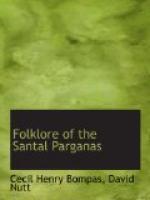As all the other boys had got away the sipahis turned their attention to him, but as they aimed blows at him with the sticks, he caught the blows on his arms and the sticks shivered to atoms without harming him; so then they went to kick him but a great cibei snake came rustling up behind them; so they saw it was no use to contend with him and desisted: whereupon he drove all the village cattle home in triumph.
The sipahis reported to the Raja how the cowherds had all made good their escape, and how the paramanik’s herd boy had driven off the cattle. Then the Raja told them to go that afternoon at the time the cattle were brought home for the night and wait at the end of the village street and then give the cowherds the thrashing they deserved; The sipahis did as they were ordered and that evening waited for the returning herd boys; and caught them as they came home and thrashed them within an inch of their lives. The others were all left senseless on the ground: but the sipahis did not dare to lay hands on the paramanik’s herd boy, he drove the cattle back into the village, and told the villagers what had been done to their sons. So the villagers went out with beds and carried the wounded boys home; then they assembled and resolved to go and punish the Raja, so they went to him and asked what he meant by killing their children. “Dear me,” said the Raja, “are they really dead?” “Well, if not not quite dead, they are very ill,” was the answer. “I am sorry,” said the Raja: “I admit that I have done wrong, but if you will forgive me this time, I will undertake to cure them in a minute and make them as well as ever; go and fetch them here.”
So the Santals went off to fetch the wounded cowherds and carried them to the Raja, all lying senseless on beds and put them down before him. While they were away the Raja had told his sipahis to grind some good hot chilis; and when the cowherds were brought to him he told the sipahis to thrust the chili paste up their noses; this was done and the smarting soon made the cowherds jump up and run away in a very lively fashion, and that was the way the Raja kept his word and cured them.
XLIX. The Foolish Sons.
There was once a man of the blacksmith caste who had six sons; the sons were all married and the whole family lived together. But the sons’ wives took to quarrelling and at last the sons went to their parents and proposed that they should set up separate households, as the women folk could not live in peace.
The blacksmith and his wife did not like the idea at all and pointed out that it would be most inadvisable; while, so far, there was plenty of food and clothing for all, they would find it much more expensive to have seven separate households and split up what was quite enough so long as they lived together, and what was to become of their old parents who were now too old to work? The sons protested that they would support their father and mother as long as they lived, even though the family separated.




